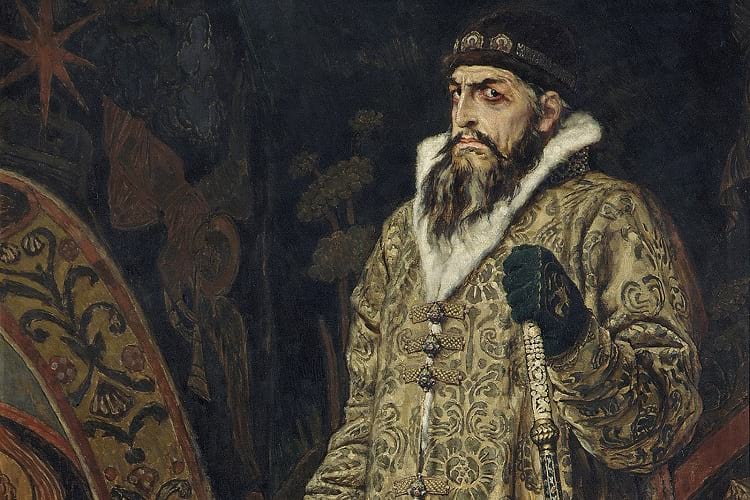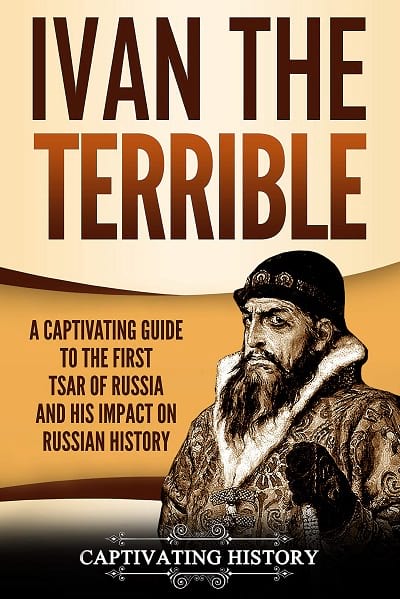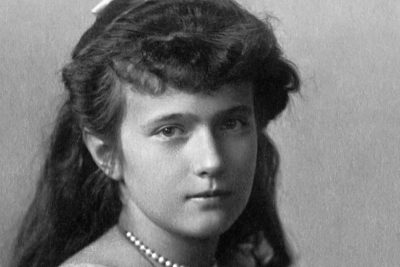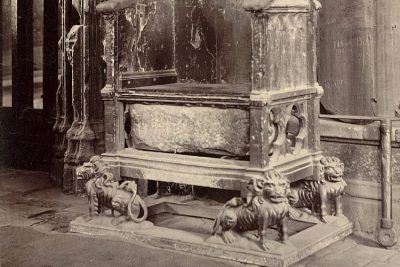Ivan the Terrible: The First Tsar of Russia and His Reign of Terror
Share

Painting of Ivan IV Vasilyevich more commonly known as Ivan the Terrible. (Tretyakov Gallery / Wikimedia Commons)
Russia has a fascinating history, akin to the likes of book and television series Game of Thrones in terms of many ruthless families vying for power and promoting their right to rule. One such family was that of Tsar Ivan IV, more commonly known as Ivan the Terrible. To continue the Game of Thrones comparison, he would represent the Mad King, or rather vice versa. Needless to say, it would not be a surprise if Ivan inspired the Mad King character. It must be noted that the moniker Terrible follows a more archaic meaning, as in to evoke terror. As opposed to the more modern meaning, of defective or bad. For Ivan the Terrible evoked terror in many people.
Background
By many accounts, Russian history began in 882 ACE, with the historical state of Kievan Rus initiated in Kiev – the capital of Ukraine – as it still stands today. This is a major reason why political and civil unrest persists between Ukraine and Russia. The Ukrainian governments have even insisted recently that the capital be Latinized and known worldwide as Kyiv (the Ukrainian way) as opposed to Kiev (the Russian translation.) Border disputes and protests still persevere with some Ukrainians wanting to be part of Russia, and some wanting to stay. Not to mention the matter of being a member state of the European Union.
The most accepted theory today is that Rus was created by Vikings, or the Varangians as the Slavic people call them. Widely recognized to be tribes from Sweden were commissioned to sail down the countless rivers snaking from the Baltic Sea into Rus. With the Slavic lands in disarray a Viking king called Oleg came to restore order, taking over and uniting many Slavic and Finnish tribes under one banner. He became ruler of Novgorod (a nearby city) in 879 ACE, succeeding a prince called Rurik, another Viking who had already established control of many regions including Novgorod which he ruled since 862. Oleg seized Kiev three years later in 882 ACE. The seeds had been planted for the Rurik Dynasty to dominate by this point which would last until 1598, compromising Kievan Rus and Muscovy (later named Moscow). It would have many famous and infamous rulers such as Alexander Nevsky, Ivan the Great alongside his cursed grandson Ivan the Terrible.
The early life of Ivan the terrible
Ivan Vasilyevich had a tumultuous early life which could be common for royal children of that time if they did not have strong family connections or if disaster struck. This was the case for young Ivan whose father died of an infected abscess when Ivan was three, and his mother died when he reached eight (many believe she was poisoned by ambitious family members).
Here began accounts and hearsay of Ivan as a disturbed and torturous individual. There are many sources for these but none are confirmed meaning much of it is still conjecture. Alas, based on his future acts there is perhaps a hint of truth in these horrors. He was said to torture animals, throwing them out the windows of the Kremlin. Later in life, there are reports that he used to beat, rape and hunt people. Even gouge out the eyes of talented architects who made beautiful structures for him so they would not be repeated again.
When his father passed Ivan was made the Grand Prince of Moscow yet his mother acted as regent during this time, controlling the nation on behalf of young Ivan. After her death, many Boyars (an elite class of families in high positions) strived for power, reportedly with many of their own interests at heart. At sixteen, in January 1547, Ivan was crowned the Tsar of Russia. He would be the first to hold this position as he created it. Taking the word from the Roman Caesar, the ambitious Ivan IV maintained that Russia would be the Third Rome.
To find a suitor for the young Tsar, at this time it was common to conduct a bride show, with up to 1500 daughters of noble families brought to court for the ruler to choose. Ivan IV chose Anastasia Romanovna – a famous name (Romanov) which would become more famous as it brought an already wealthy and powerful family, into more power and wealth. She held the title of the first Tsarina.
Early tests
In the summer of 1547, months after his coronation a fire would spread through the Russian Capital of Muscovy. In those times most buildings were made from wood which proved highly flammable when such an accident or arson attack occurred. The cause was never established but a political rival of the Tsar’s family – Yuri Glinsky – was accused of starting the blaze to cause upheaval in the Tsar’s kingdom. He was stoned to death. His family would later be removed from the government three years later by the spiritual leader of Russia – St. Macarius Metropolitan, further strengthening the position of Ivan. The Metropolitan is the head bishop, having authority over all bishops of an area such as Muscovy (mostly in Christian, and Orthodox churches) – he was very close to Ivan IV. The church and state continue to operate closely in many countries nowadays, arguably none more so than the Russian Federation.
Ivan set up his own council of advisors from the high-class families of Moscow. His advisors would consort with him regarding policy changes, the main ones being self-government in rural regions, improvements to tax collections and reforms in church and state. He improved the Sudebnik in 1550, a code of nationwide laws first founded by his grandfather. He also enlisted the first Streltsy – a permanent, standing army – who are still employed in the present day. The Moscow Print Yard was set up by Ivan in 1553 which seems an incredible endeavour and advancement. But tell that to the scribes of Moscow who were losing work fast. They tried to burn down the building and extort Russian printers, forcing some to flee the capital.
In terms of Foreign Policy, the Mongol Hordes were the biggest threat to Russia and Europe, made famous by the likes of Attila the Hun. Even after the decline and break-up of the Golden Horse their former lands were split into Khanates which proved rivalrous to Russia. They ruled the lands of Kazan and Astrakhan until Ivan defeated them in battle. One of the most famous structures in the world, let alone Russian, was commissioned with St. Basils Cathedral, to signal these victories and the conquering of the city of Kazan. He would not have the same success against another main rival in Lithuania to the west. Access to the Baltic Sea was demanded but they could not break through the federation of nations protecting it. In terms of trade, Ivan was happy to do business with England, opening up the White Sea port of Arkhangelsk to them. They would persistently maintain a close relationship with Great Britain in the centuries to come.
Ivan’s thirst to conquer the lands of Siberia turned successful when a rich family called the Stroganovs funded the expedition. They hired Yermak Timofeyevich – a Cossack (Eastern Slav) – who brought the stretching steppe under the red of Russia. Of course, much of Siberia was and still is uninhabited; the imperialism was simply in name, with tribes such as the Nogai Horde (a Turkic and Mongol diaspora) pledging allegiance.
Ivan’s secret police
When things started to go wrong for Ivan politically he abdicated in 1564. This was after several pitfalls which when combined plunged Russia into economic disparity. Drought and famine ensued because of defeats in war, invasions by the revenge-seeking Mongols, not to mention sea blockades by rival nations. Even the Ottoman Empire in the south became another thorn in the wilting rose, who would raid Russia for slaves as did the Crimean Khanate. The boyars pleaded for the Tsar to return to Moscow and he did so only after being granted absolute power of the Moscow region, the right to do so becoming known as the Oprichnina. This allowed him to create a secret police-come-bodyguard division known as the Oprichniki to keep the peace and protect his family.
Dressed in all black, riding jet-black horses they terrified the residents of Russia particularly when Ivan started to exhibit signs of madness. His dear wife, Anastasia Romanova was presumed poisoned in 1560 which is said to have been a driving force in the degeneration of the Tsar. Forensic autopsy uncovered a high level of Mercury in her bones (more so than common cures of the time would leave) to possibly prove this. Defection to Lithuania by many of his advisors led to more paranoia and distrust.
A thousand strong at its onset the Opichniki were based in Novgorod. They were headed by a ruthless character called Malyuta Skuratov who even killed a Metropolitan named Phillip on orders from his Tsar. Their wages were more than handsome as they looked to battle corruption and treason among the elite families which Ivan suspected of usurping him. He deliberately picked members from the low classes of Russia and even from other nations meaning they had no links to the Boyars and were loyal to him only. Their banners displayed a severed dog’s head.
A famous text written in Old Russian (used between the 15-20th Century) describes the massacre of Novgorod on orders from Ivan IV who led the battalions with his heir apparent Ivan. He believed conspirators to be rotting the core of the historic city. A plague had already struck the land with hundreds dying daily but more tragedy would arrive. Theorists blame the Oprichniki for taking too much from the peasants, as well as Russia’s doomed wars, including the Livonian War with their old enemy Lithuania among others.
Up to 60,000 people were executed in Novgorod; many tied to carts and wheeled into the Volkhov River for alleging to conspire against the Tsar. Many others were deported. With more research, it seems the numbers were significantly lower but the extermination and even pogroms did occur meaning Ivan’s madness was spiralling out of control.
Ivan the terrible and his son Ivan
By the end of Ivan’s reign, Russia was struggling economically. It would be a prelude to the Time of Troubles which plunged the Rurik Dynasty into disarray by the time Ivan’s son Feodor ascended the throne. Ivan started having vicious outbursts in court. He would imprison and torture countless people he believed to be traitorous, mostly Boyars. This sustained in his private life as accounts tell that he beat-up his daughter-in-law, due to a clothing disagreement. He then killed his son and heir Ivan when confronted about the attack, hitting him with as sceptre yet showing remorse immediately after. But these accounts may be exaggerated again, possibly lies from the elite looking to displace the Tsar. On the other side, Ivan was a devout follower of Orthodoxy, a representative of God – to the point that the punishments he administered were considered just to him if his victims had sinned.

Ivan after he killed his son; painting by Ilya Repin. (Tretyakov Gallery)
Whether true or not, it plunged Russia into uncertainty and jeopardised the Rurik Dynasty. It was said Ivan’s namesake Ivan Ivanovich was the only viable heir as his other son Feodor had mental and physical problems. A regent ruled for Feodor until he passed childless to finally end the Rurik Dynasty in 1598.
The death of the Tsar
On March 18, 1584, Tsar Ivan IV met his end due to a stroke while playing chess. Rumours heightened that a murder was behind it but Soviet scientists who excavated the grave found that Ivan IV died of natural causes.
While Ivan IV had obvious success with political reform and transformed Russia in many ways his psychotic methods (however exaggerated)– even for the time – is why he will never shed the moniker of Ivan the Terrible.
Enjoyed this article? Also, check out “Rasputin, Faith Healer? Or Lustful Charlatan?“.
Fact Analysis:
STSTW Media strives to deliver accurate information through careful research. However, things can go wrong. If you find the above article inaccurate or biased, please let us know at [email protected]
 Recommended Read:
Recommended Read:
Ivan the Terrible: A Captivating Guide to the First Tsar of Russia and His Impact on Russian History | By Captivating History
Genre:
Non-fiction > History













